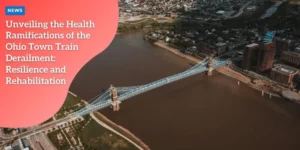The Economic Impact of High Rent: Unveiling the Burden of Credit Card Debt Among Americans
By: marcus Posted in: April 9, 2024 Last Update: March 11, 2025

Introduction
Imagine a peaceful, small town that was once a symbol of community and tranquility, only to be thrust into the national spotlight, not for celebratory events or technological breakthroughs, but because of a devastating crisis.
Anúncios
This is the story of East Palestine, Ohio—a community that, without warning, faced a tragic and transformative event that would alter the lives of its residents forever.
In a matter of moments, an ordinary day in this charming town became synonymous with fear, uncertainty, and the struggle to rebuild both physically and financially.
The train derailment that took place in East Palestine was more than just an accident—it was a catastrophe with far-reaching consequences.
Anúncios
The derailment not only disrupted daily life but raised serious concerns about the town’s future, particularly regarding health and economic stability.
In its aftermath, residents faced enormous challenges, especially with the economic toll and rising financial instability that came with it.
What followed was a complicated and ongoing struggle for the people of East Palestine, where issues related to health concerns, housing, and financial survival came to the forefront of daily conversations.
Anúncios
Overview of the Train Derailment Incident in East Palestine, Ohio
On an otherwise routine day, East Palestine, Ohio, was shaken by a catastrophic event—a train derailment.
What began as a minor disruption escalated rapidly into a full-scale emergency with profound implications for the entire community.
The derailment involved several freight cars, some of which were carrying hazardous materials, a factor that dramatically intensified the incident’s impact.
As the cars careened off the tracks, they ignited a massive fire that raged for days, sending plumes of smoke into the sky and causing widespread fear among residents.
Emergency response teams sprang into action, and the community was swiftly evacuated, with local authorities issuing evacuation orders due to concerns over the potential risk of toxic exposure.
As the fire subsided and the immediate danger passed, a new set of worries emerged—how would this incident affect the long-term health and well-being of the community? More urgently, what would happen to the financial stability of East Palestine’s residents, many of whom were renters, businesses, and workers who had little financial cushion to weather such a devastating blow?
The derailment’s impact was not confined to physical destruction alone.
As the local population returned to what was left of their homes and businesses, many were left grappling with the realization that the road to recovery would be much longer and more difficult than they had initially anticipated.
As hazardous chemicals may have leaked into the environment, concerns about air and water contamination remained high.
The mental, emotional, and physical toll on the community was profound, but perhaps even more pressing was the looming financial crisis that residents faced in the wake of the disaster.
Brief Summary of the Ongoing Health Concerns and Community Division in the Town
The aftermath of the derailment continues to weigh heavily on the residents of East Palestine.
While some members of the community are eager to move on, others remain deeply concerned about lingering health risks.
The potential exposure to toxic chemicals has created a palpable sense of division among the town’s residents, with some seeking assurance that everything will return to normal, while others worry that the worst may still be to come.
Health issues ranging from respiratory problems to long-term environmental damage have fueled an atmosphere of uncertainty and mistrust in the recovery process.
At the same time, this division within the community has compounded the financial struggles faced by East Palestine’s residents.
For many, the fear of long-term health consequences affects their ability to return to work and earn a living, while the lack of financial support from government agencies or insurers has made it even harder to rebuild.
Emotional stress and anxiety about the future only add to the burden, leading many to find themselves in a cycle of financial instability.
In this context, the toll of the derailment extends far beyond the physical realm, affecting the emotional and economic fabric of the town.
The Financial Toll of High Rent
Renting a home can often be seen as a practical and flexible choice for many families.
It offers an alternative to homeownership, providing a sense of mobility and financial agility.
However, when disaster strikes, the true vulnerabilities of renting become painfully apparent.
The financial consequences of the train derailment were felt most acutely by renters in East Palestine, many of whom found themselves in a precarious position.
The financial implications were not limited to property damage alone; renters suddenly found themselves faced with unforeseen expenses, ranging from increased housing costs to relocation fees, all while their regular income streams were interrupted.
For renters, the derailment was not merely a disruption in their housing situation—it created a cascade of financial difficulties.
Most renters do not have comprehensive insurance coverage that would protect them in the event of such a disaster.
As the residents were forced to evacuate their homes, many were uncertain about when or if they would be able to return.
This created an environment of financial instability, where people had to weigh the cost of finding temporary housing against the possibility that their homes might no longer be safe or habitable.
Financial Implications of the Train Derailment Incident on the Residents
The financial fallout from the derailment was swift and severe.
As East Palestine struggled with environmental and health concerns, residents found themselves facing immediate economic challenges.
The derailment’s impact reverberated across the community, especially for renters who typically have fewer resources and less stability compared to homeowners.
These individuals found themselves without the cushion of property ownership or insurance coverage, making it all the more difficult to navigate the aftermath of the disaster.
For many, the uncertainty surrounding the safety and habitability of their rental properties led to added financial strain.
Some were forced to find new places to live, often at higher rates, while others incurred additional costs related to relocating.
In some cases, renters had to pay for temporary housing, which added to the financial burden.
Moreover, many had to spend money on replacing personal belongings that were damaged or destroyed in the derailment, further compounding their financial woes.
The financial pressure was exacerbated by a general sense of fear and panic.
Many residents turned to credit cards and loans to cover the increased costs of housing, healthcare, and daily expenses, even though they had limited ability to repay these debts in the short term.
For those without sufficient savings or emergency funds, the cost of recovering from the derailment became an overwhelming challenge.
Factors Contributing to Debt Accumulation
In the aftermath of the derailment, East Palestine’s residents saw a sharp increase in debt accumulation.
Several factors contributed to this financial spiral:
1. Loss of Income
Many local businesses that were affected by the derailment either shut down temporarily or faced significant reductions in customer traffic. This resulted in job losses, reduced working hours, or decreased income for many individuals, adding to the financial stress. Without a steady income, many turned to credit cards or loans to cover day-to-day expenses, adding to their debt load.
2. Medical Expenses
The health risks associated with the derailment led to increased medical expenses for many residents. For those who did not have adequate health insurance or coverage, these costs could quickly become overwhelming. Medical bills, prescriptions, and treatments that were once affordable became unaffordable for those already struggling financially, leading them to use credit cards or loans to make ends meet.
3. Relocation Costs
For some residents, the safety concerns in the aftermath of the derailment led them to relocate temporarily or permanently. The costs of moving—such as hiring movers, paying security deposits, and securing new housing—added additional financial pressure. In many cases, renters had to pay more for new housing, exacerbating the debt accumulation process.
All these factors combined to create a perfect storm of financial instability for East Palestine’s residents.
For many, this new reality was compounded by the emotional and psychological stress caused by the derailment and the uncertainty it generated.
In times of stress, it is not uncommon for individuals to make less prudent financial decisions, which can further escalate the situation.
Strategies for Financial Recovery
Despite the overwhelming challenges, East Palestine’s residents have begun to take steps toward financial recovery.
While the road ahead remains difficult, there are several strategies that can help individuals manage their debt and rebuild their financial lives.
Actionable Steps for Debt Management
One of the first steps to take in managing post-derailment debt is to create a comprehensive budget.
Prioritizing essential spending, cutting back on non-essential expenses, and reducing discretionary spending can help free up cash for debt repayment.
Additionally, individuals should consider negotiating payment terms with creditors, as many may be willing to extend grace periods or offer reduced rates for disaster-affected individuals.
For those with high-interest debt, consolidating or refinancing loans through low-interest credit cards or personal loans could be a smart way to manage costs.
Seeking financial counseling or professional advice can also provide valuable insights into how best to approach debt repayment in the aftermath of a disaster.
Many financial experts recommend that individuals who are struggling reach out for assistance as soon as possible, as the earlier one seeks help, the better the chance of avoiding long-term financial damage.
Community Support and Resources
In addition to individual financial strategies, there are numerous community resources and government programs available to help residents of East Palestine recover.
Local organizations, disaster relief programs, and government agencies may offer assistance in the form of food banks, grants, and unemployment benefits.
These programs can help alleviate some of the immediate financial burdens faced by affected residents.
For many, community support is a crucial part of the recovery process.
Whether it’s emotional support, practical help, or simply the sense that others are in the same boat, connecting with others in similar situations can provide much-needed relief.
Conclusion
The aftermath of the train derailment in East Palestine, Ohio, has brought to light the profound economic challenges facing the community.
Rising rents, mounting credit card debt, and the uncertainty of the future have left many residents grappling with financial instability.
However, amid these challenges, the resilience of the town’s people is evident.
With the right strategies for debt management and access to community support, recovery is possible.
If you are one of the many affected by this disaster or facing similar financial hurdles, remember that you are not alone.
There are resources available to help guide you through this difficult time.
With determination, community support, and a strategic approach, it is possible to navigate the financial aftermath of the East Palestine incident and regain a sense of stability.
Together, we can rebuild stronger than before.





